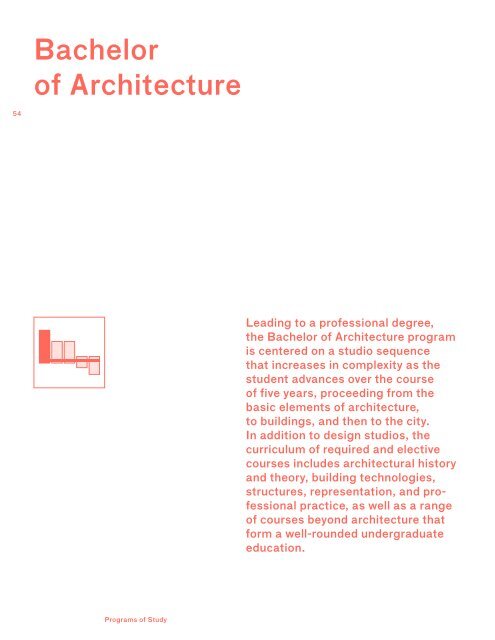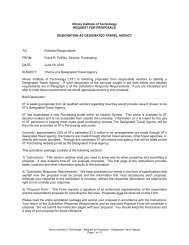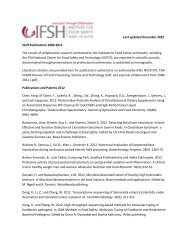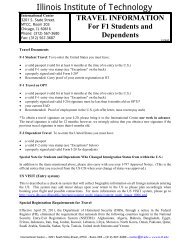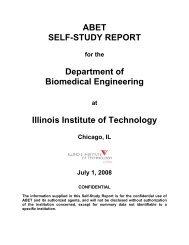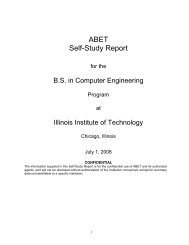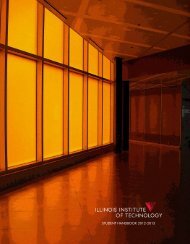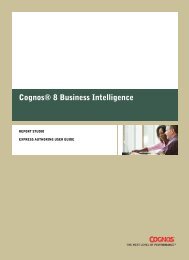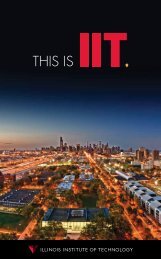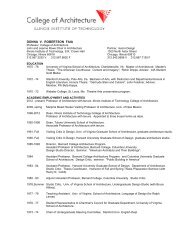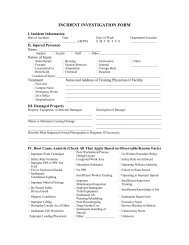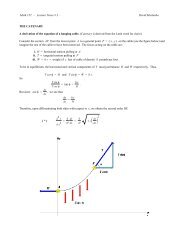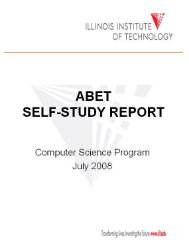Nowness - Illinois Institute of Technology
Nowness - Illinois Institute of Technology
Nowness - Illinois Institute of Technology
You also want an ePaper? Increase the reach of your titles
YUMPU automatically turns print PDFs into web optimized ePapers that Google loves.
Bachelor<br />
<strong>of</strong> Architecture<br />
The program begins with an introduction<br />
to the history <strong>of</strong> architecture and to the<br />
contemporary pr<strong>of</strong>ession, helping students<br />
understand the variety <strong>of</strong> paths that their<br />
architectural education could follow. Initial<br />
studio assignments develop communication<br />
skills—verbal, graphic, and written—that<br />
enable students to navigate their field while<br />
also introducing them to the elements that<br />
comprise architecture—surface, wall, door,<br />
opening, stair, room. With an emphasis on<br />
how things are made, students will be asked<br />
to consider fundamental questions: What<br />
is a door? How does its making inform its<br />
design? How does its design impact the wall<br />
surrounding it? This initial period culminates<br />
in the design <strong>of</strong> a small structure encompassing<br />
all <strong>of</strong> the elements explored in the<br />
preceding exercises.<br />
In the second year, studio assignments<br />
center on urban dwelling via the study <strong>of</strong> a<br />
small house in the city. The student is introduced<br />
to fundamental aspects <strong>of</strong> building:<br />
space, structure, materials, and construction.<br />
Students begin by researching historical<br />
precedents and analyzing how the concept <strong>of</strong><br />
living in the city has changed over time, and<br />
proceed with a study <strong>of</strong> contemporary issues<br />
and building methods that will inform their<br />
design. Driven by informed speculation, this<br />
period concludes with an exercise in imagining<br />
the home <strong>of</strong> the future. How will changing<br />
demographics and family patterns affect the<br />
home <strong>of</strong> the future? What impact will climate<br />
change have on how we live?<br />
The third year <strong>of</strong> design studios introduce<br />
more complex sites and programs in the study<br />
<strong>of</strong> multiple and hybrid buildings in the city.<br />
Students move beyond the single building<br />
to consider the spaces between buildings,<br />
infrastructural elements, and neighborhoods.<br />
Initial research phases are followed by studio<br />
assignments that include the design <strong>of</strong><br />
mixed-use buildings with hybrid structures,<br />
and projects comprised <strong>of</strong> multiple building<br />
elements. Students explore the architect’s role<br />
in the making <strong>of</strong> a neighborhood and end with<br />
a project on the neighborhood <strong>of</strong> the future.<br />
54 55<br />
Leading to a pr<strong>of</strong>essional degree,<br />
the Bachelor <strong>of</strong> Architecture program<br />
is centered on a studio sequence<br />
that increases in complexity as the<br />
student advances over the course<br />
<strong>of</strong> five years, proceeding from the<br />
basic elements <strong>of</strong> architecture,<br />
to buildings, and then to the city.<br />
In addition to design studios, the<br />
curriculum <strong>of</strong> required and elective<br />
courses includes architectural history<br />
and theory, building technologies,<br />
structures, representation, and pr<strong>of</strong>essional<br />
practice, as well as a range<br />
<strong>of</strong> courses beyond architecture that<br />
form a well-rounded undergraduate<br />
education.<br />
The fourth year <strong>of</strong> the studio sequence is<br />
focused on comprehensive building design.<br />
Here, students consider contemporary building<br />
practices in a more in-depth manner that<br />
stresses the integration <strong>of</strong> structure, envelope,<br />
and building systems into a unified whole.<br />
Studio assignments are large institutional<br />
buildings in the city with more complex programs<br />
and students are asked to consider the<br />
nature <strong>of</strong> how such institutions interface with<br />
the urban environment. How does the institution<br />
engage the city in a dialogue? What is<br />
changed or activated by its presence? What<br />
does the building say about its urban context?<br />
Finally, the fifth year is focused on urban<br />
design and is more speculative in nature.<br />
Students select from a menu <strong>of</strong> studio<br />
options and work side-by-side with Master<br />
<strong>of</strong> Architecture, Master <strong>of</strong> Science, and<br />
Ph.D. degree candidates in research-based,<br />
forward-looking studios that speculate on<br />
the city <strong>of</strong> the future. What is our vision <strong>of</strong> an<br />
urban future? What is the role <strong>of</strong> the architect<br />
in its realization? These and other questions<br />
are explored in studios, related coursework,<br />
and special seminars that focus on the emerging<br />
issues <strong>of</strong> the global city organized by a<br />
yearly theme under the umbrella <strong>of</strong> “The New<br />
Metropolis.” This yearly theme binds the<br />
studios together thematically, and underpins<br />
the discourse <strong>of</strong> IIT Architecture. Lectures,<br />
symposia, exhibitions and master classes all<br />
intersect with this theme and, together with<br />
the advanced studios, define IIT’s position<br />
within the discipline <strong>of</strong> Architecture and constitute<br />
its statement to the world at large.<br />
Programs <strong>of</strong> Study<br />
Programs <strong>of</strong> Study


